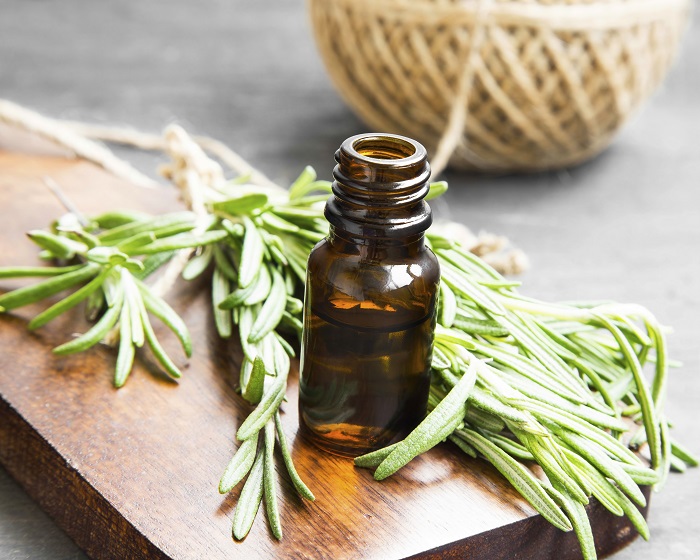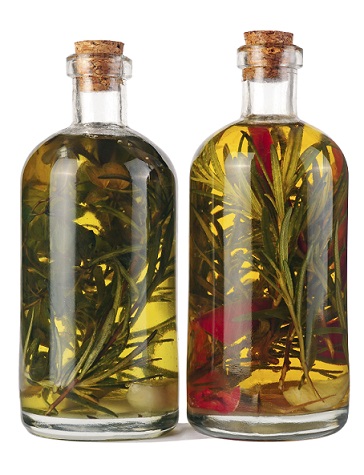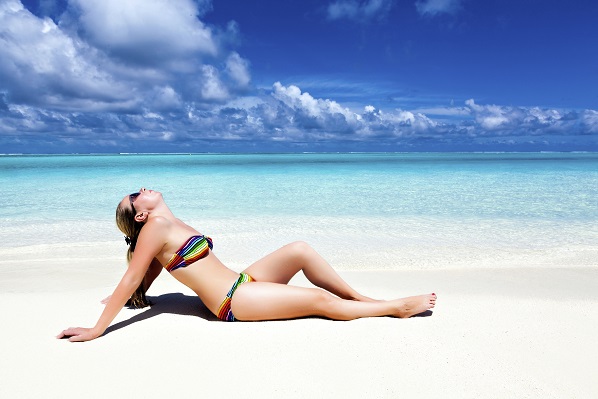 Rosemary (Rosmarinus officinalis) is a small evergreen shrub that grows most heavily in Mediterranean countries such as Spain, Italy, Portugal, Southern France, Greece, North Africa, and areas of Turkey, Lebanon and Egypt. It grows in particular abundance near rocky limestone hillsides by the sea.
Rosemary (Rosmarinus officinalis) is a small evergreen shrub that grows most heavily in Mediterranean countries such as Spain, Italy, Portugal, Southern France, Greece, North Africa, and areas of Turkey, Lebanon and Egypt. It grows in particular abundance near rocky limestone hillsides by the sea.
Rosemary is most famous as a culinary herb, particularly in Italian cuisine where it’s believed to compliment the taste of lamb extremely well. Rosemary herbs have been revered for a long time; in Ancient Greece they believed it could enhance and strengthen memory.
However, what we’re interested in today is rosemary extract, specifically as a topical treatment. We’ve already discussed essential oils derived from herbs, like thyme oil and tea tree oil, both excellent weapons against p.acnes bacteria.
Does rosemary extract, not to be confused with the anti-inflammatory rose water, which we’ve also covered, reduce acne when applied to the skin? According to a fantastic 2013 study, the answer is a very firm yes.
Study – rosemary calms inflammation from acne bacteria
Rosemary extract and oil already have tons of great studies on the indirect conditions behind acne. For instance, they both reduce inflammation, kill a wide spectrum of bacteria, hoover up free radicals, and protect against UVB radiation (see below).
However, we now have a specific study inhibiting propionibacterium acnes, or p.acnes, the classic acne bacteria that triggers an inflammatory response and leads to pimple formation.
The Taiwanese scientists started with a test on cells (in vitro). When p.acnes was absent, the rosemary extract had no effect on tumour necrosis factor alpha (TNF-a), interleukin-8 (IL-8), and interleukin-1beta (IL-1beta), or other pro-inflammatory chemicals behind acne. But when p.acnes was present, rosemary extract “significantly suppressed” every chemical.
That’s excellent news, as those chemicals are the link in the chain between acne bacteria and eventual pimple formation.
Rosemary extract also reversed a spike in NF-kappaB, the “master molecule” of inflammation which controls all the chemicals above. Rosemary extract didn’t just lower inflammatory chemicals; it reduced their production at the genetic level.
Read Annihilate Your Acne – get the ultimate diet and clear your acne permanently!
Rosemary extract reduced the inflammation of cells exposed to p.acnes for both 8 hours and 16 hours. Most interesting was the compounds responsible; scientists identified rosmarinic acid, carnosol, and carnosic acid.
Each specialised in different inflammatory chemicals; rosmarinic acid reduced interleukin-8 production, but had no effect on interleukin-1beta. Carnosol and carnosic acid, meanwhile, significantly inhibited IL-1β at the lower concentrations of 2.5 μM, but increased IL-8 secretion at higher levels, which is no problem, since the overall extract was shown to lower IL-8.
Happily, the contents of carnosol, carnosic acid, and rosmarinic acid in the extract were 0.57, 1.98 and 0.43 mg per gram of dried leaves, respectively.
None of the three compounds inhibited the pro-inflammatory chemical TNF-a either. What makes that so great? Well, the entire rosemary extract did reduce TNF-a substantially, so there’s almost certainly other acne-clearing compounds that the scientists didn’t identify.
Later, the Taiwanese scientists speculated that ursolic acid and luteolin, which are known to reduce TNF-a, could be responsible. They then mentioned how a “vast number” of phytochemicals have been identified in rosemary.
Part 2 was a study on living animals (in vivo), where scientists injected mice ears with p.acnes to purposefully induce inflammation. The ears swelled up and reddened accordingly. Rosemary extract was applied, and bingo: ear thickness and swelling was reduced, and p.acnes-induced ear inflammation calmed down.
The scientists were cautious about side effects: “it is still obligatory to evaluate the safety and efficacy of rosemary extract and/or its bioactive ingredients when they are administered topically for acne therapy”. However, none were reported in the study, and clearly, they’re looking to the future.
Recommended – the top 6 vitamins and minerals for acne-free skin
There was no cytotoxicity, no apparent irritation, such as ear swelling and redness, and no increased neutrophils, another type of inflammatory chemical. As they said: “a sole injection of rosemary extract did not cause either skin irritation or inflammation”.
Rosemary extract destroys the bacteria’s shape
That’s not the only excellent study directly examining p.acnes bacteria. This 2007 study led by Dr Fu gave a vivid description of how rosemary essential oil warped the size and shape of bacterial bodies. At very low levels, the p.acnes’ length, width and height weren’t affected (the last two grew slightly), but when the dosage was increased, they fell by 42.56%, 92.00% and 41.58% respectively. A crushing reduction in other words.
Apparently, 1) treated bacteria lost their native shape, 2) the cell wall morphed and lost its shape, 3) the cells of the cell wall started shedding uncontrollably, 4) cytoplasm leaked out the bacterial body, and 5) the bacteria finally died. The p.acnes was pretty much obliterated.
We have two studies showing that rosemary extract eliminates a main formation point in acne. Rosemary extract can 1) lower inflammation from p.acnes, and 2) kill p.acnes itself.
The many compounds of rosemary extract
 So how does it work? Unlike tea tree oil, or thyme oil, which get their powers from 4-terpinol-ol and thymol respectively, rosemary extract has several powerful plant compounds.
So how does it work? Unlike tea tree oil, or thyme oil, which get their powers from 4-terpinol-ol and thymol respectively, rosemary extract has several powerful plant compounds.
There’s rosmarinic acid, carnosol, carnosic acid. By weight, the main constituents of rosemary oil, itself a key component of rosemary extract, are bornyl acetate (20.27%), caryophllene (13.61%), eucalyptol (12.84%) camphor (6.41%), camphene (4.19%), borneol (3.61%), and α-caryophyllene (2.53%). Rosemary extract also contains ursolic acid and luteolin. Some of the best compounds are…
Cineol (eucalyptol) – a common plant compound most notably found in eucalyptus oil. By weight, it’s the most abundant compound in rosemary oil, forming 35-45%. Eucalyptol has a pleasant spicy taste and aroma, and hence, is actually one of the 599 additives added to cigarettes.
Interestingly, eucalyptol is toxic to many varieties of bacteria; it’s a main active ingredient in antibacterial mouthwashes such as Listerine. It’s also anti-inflammatory enough that it’s an ingredient in many cough drops. Elsewhere, it’s used in many flavourings, fragrances and cosmetics. Eucalyptus oil is also a natural insect repellent for pests like mosquitoes.
Does it cure acne – eucalyptol has no studies on acne inflammation directly. However, this study showed reduced lung inflammation in mice exposed to cigarette smoke. This double-blind placebo controlled trial found reduced lung inflammation in asthma patients.
The top 7 topical treatments for clearing acne naturally
Eucalyptol even reduces inflammation in the brain amyloid plaques of Alzheimer’s patients (study). The best study I’ve discovered found that eucalyptus oil lowered oil production, by simply shrinking the sebaceous glands, and could thus control acne.
Rosmarinic acid – the signature compound of rosemary extract. First discovered in 1958, this is structurally similar to the healthy caffeic acid found in coffee beans. Low levels are found in many herbs, but rosemary oil and perilla oil are the famous sources. Perilla oil is used in traditional Japanese medicine to combat allergies.
According to rat studies, rosmarinic acid is absorbed directly into the skin. The big question: what does it do when it gets there?
Does it cure acne – there’s a goldmine of great studies on rosmarinic acid. This 2004 study tested a perilla oil extract containing 68% rosmarinic acid on skin inflammation. Neutrophil production plummeted, but by less when rosmarinic acid concentrations were lower. Neutrophils are inflammatory chemicals which spew out free radicals to break down dying cells. They’re healthy in moderation, but armies of them can bombard even your healthy skin cells. Rosmarinic reduced free radicals as well, particularly lipid peroxides, the most potent free radicals at causing acne. Thiobarbituric reactive substances fell nicely, a by-product of lipid peroxide activity.
This study on oral rosmarinic acid found reduced lipid peroxides in the brain of rats, which should translate when applied topically. This 2009 study is truly superb. Both rosmarinic acid and rosemary extract itself slashed levels of interleukin-6, interlukin-1beta, TNF-alpha when applied topically. But taking it to the next level, rosmarinic acid also boosted the skin’s glutathione levels, the all-important acne antioxidant, while inhibiting lipid peroxides once again.
Rosemary extract has stronger antioxidant powers than even ascorbic acid (vitamin C), according to this study. Interestingly, this study fed rats rosmarinic acid alongside lycopene, the signature medicinal compound from tomatoes and watermelon. While both reduced the oxidation of LDL cholesterol decently, they had a synergistic effect when combined. These studies alone may not reveal rosemary extract’s true strength; rosmarinic extract could be even stronger for acne in a natural package with carnosol, cineol, and carnosic acid.
Alpha-pinene – a diterpene antioxidant found in rosemary extract, and also juniper berries, eucalyptus oil, and tea tree oil.
Does it clear acne – almost certainly yes; two studies have been conducted directly on p.acnes bacteria.
In the first study, scientists were scouring the world for new natural acne cures. They landed on guava oil and eucalyptus oil, and both showed good antimicrobial activity against p.acnes. The relevance? The main constituent of that guava oil was alpha-pinene.
Why using raw honey could revolutionise your skin
Our second study analysed tea tree oil’s various compounds. Terpinen-4-ol, alpha-terpineol, and alpha-pinene were all found to be active against staphylococcus aureus, staph. epidermidis and propionibacterium acnes. It’s not surprising, as according to that study, alpha-pinene is a natural “broad spectrum antibiotic”.
Carnosol – a phenolic diterpene antioxidant found in rosemary and mountain desert sage. First discovered in 1964. Rosemary extract contains two compounds, called carnosol and carnosic acid, however carnosol is a derivative of carnosic acid and the subject of most studies. Carnosol has been studied for anticancer benefits on a wide variety of cells. Carnosol and carnosic acid make up 5% of rosemary leaves, and are believed to account for 90% of antioxidant activity. That’s very interesting, seeing as rosmarinic acid is already a potent antioxidant.
Does it clear acne – this study found that purified carnosol and carnosic acid are powerful inhibitors of lipid peroxidation. They reportedly inhibit inflammation at the genetic level (study), and a big review of studies from 2011 called carnosol “a promising anti-inflammatory agent”. Carnosol inhibits numerous pro-inflammatory messengers, including COX-2 (study) and NF-kappaB (study).
The best study I’ve seen applied carnosol to inflamed mouse skin and observed greatly reduced COX-2, IL-1B and TNF-a activity. Carnosol soothed the swollen mouse ear substantially. Rather than simply reducing the chemicals, the scientists concluded that carnosol can regulate genes related to inflammation.
Unique power alert – sunlight protection
 Killing acne bacteria, lowering inflammation, and hunting down free radicals are all reasonably common topical powers, but there’s one benefit of rosemary extract which isn’t: increasing your skin cells’ resistance to UV radiation.
Killing acne bacteria, lowering inflammation, and hunting down free radicals are all reasonably common topical powers, but there’s one benefit of rosemary extract which isn’t: increasing your skin cells’ resistance to UV radiation.
Firstly, we have a 2016 study published just last month which tested human cells. Thanks to its antioxidant powers, rosmarinic acid deactivated nearly all of the free radicals produced by sunlight’s reaction with skin. It also reversed the depletion in superoxide dismutase (an antioxidant).
The big question is whether the whole rosemary extract retains the power or whether another compound negates it by increasing UV sensitivity. Luckily, this study found that it does.
Combining citrus and rosemary extract led to higher survival rates in cells exposed to UV radiation, and in an oral human group, taking the recipe for eight weeks increased their skin’s minimal erythritol dose (MED) by 34%. After 12 weeks, it was 56%.
Vitamin E – the ultimate nutrient for clogged pores
The MED is the UV intensity threshold where damage to the skin kicks in, so the higher your MED, the more sunshine you can cope with.
Neither experiment applied rosemary extract directly to human skin, but sunshine protectors usually work by increasing antioxidant production or through their own antioxidants which accumulate into skin cells. This would translate simply and easily to topical application.
If rosemary extract does give your skin a UV-shielding armour, then you can enjoy more sunlight without acne, allowing you to 1) have more freedom in your lifestyle, and 2) make more vitamin D from sunlight.
Another ancient secret
Out in the wilderness of acne-clearing remedies lies another potential topical treatment, which is just as popular as rosemary extract, but much less proven. It was popular in 4th century BC Ancient Greece, used by the great Pliny The Elder of the Roman Empire.
The secret is clary sage oil, AKA Salvia sclarea oil, an essential oil derived from the flowers of the clary sage plant growing on Mediterranean shores. There isn’t a single study testing clary sage oil on acne, whether as a food or topical remedy. There’s no evidence for shrinking the sebaceous glands and improving oily skin, nor for killing acne bacteria.
Despite that, there’s several bright glimmers of hope in sight. Firstly, we have clary sage’s long suspected benefits for brain health. Compared to chamomile, lavender and rosemary, clary sage strongly lowered stress levels in rats forced to undergo a swim test, and manipulation of serotonin and dopamine in the brain was believed to be responsible. This study stated that “rosmarinic acid was the predominant compound” in clary sage oil, and observed anti-inflammatory properties when it was taken orally, reducing IL-1β, IL-6 and TNF-α.
It’s an interesting situation. Clary sage has no evidence whatsoever for acne itself, but it shares the exact same brain-enhancing, anti-inflammatory rosmarinic acid found in rosemary extract. Clary sage oil has an identical ability to end depression and pump up your mood, even being superior.
The conclusion? Clary sage could easily be a hidden anti-inflammatory topical treatment for acne. It’s proven to kill the infectious bacteria staphylococcus aureus with ease; could p.acnes also be vulnerable? Given rosemary extract’s success, the answer may be yes. There’ll be differences to rosemary extract as well, in the minor phenolic compounds and phytonutrients, giving clary sage oil even more potential.
If you wish to experiment, then this Plant Therapy Clary Sage Essential Oil (amazon link) is a pure and steam distilled brand. I would still recommend trying tea tree oil or lavender oil first, but clary sage oil could be your ticket to gaining a monopoly over a hidden strategy, with everybody wondering what your secret is (just make sure you comment on it here).
The verdict and best product
Right now, rosemary extract stands alongside thyme oil: I won’t give it an official endorsement, simply because we lack first hand stories.
Unlike tea tree oil, grapeseed oil, or blue light devices, there’s no vast catalogue of testimonials on acne forums. For instance, what if rosemary extract has a tendency to dry out the skin? Anything’s possible.
The first study didn’t notice any irritation, burns, or additional inflammation, but with so many natural compounds, it’s possible that sensitivities are more common than grapeseed oil, tea tree oil, rose water, or honey. The chances are that acne patients will jump aboard the rosemary extract train soon, as they stumble across the excellent study above. Only then will the truth emerge.
Nevertheless, the studies above are highly promising. Rosemary extract is loaded with anti-inflammatory compounds, and probably builds a UV antioxidant directly into your skin. It’s an excellent choice for experimentation.
Like with clary sage oil, Plant Therapy (amazon link) is an unbeatable brand, using superior steam distillation, and rejecting all harsh chemical solvents like hexane.
So far, every single essential oil we’ve analysed has boasted just as many great studies as pharmaceutical staples like benzoyl peroxide.
Rathe than three or four default traditional ingredients, it shows us how there’s a whole world of natural treatments out there which could revolutionise your skin.
NEXT: get the complete strategy for clearing acne naturally
Thanks for reading!
